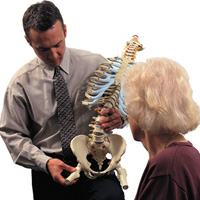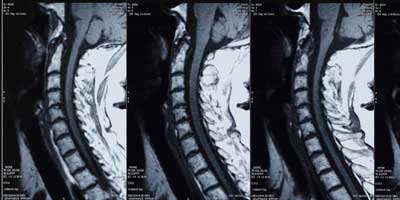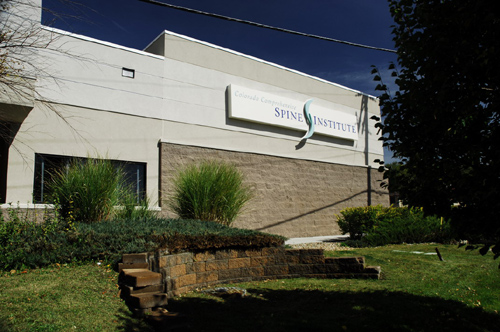Locations

Fax: (303) 762-9292

Proper Use of a Brace

The purpose of this article is to discuss the rationale for the use of braces for both the neck and back. The basic concept of a brace is to mobilize and support the spine, or possibly to correct spinal deformity. This involves both the muscular as well as the bony structures of the spine. Rigid braces are more for the purpose of immobilization. Soft, elastic type braces are more for muscular support. Before the advent of internal spinal fixation (such as rods and screws) for internal immobilization of the spine, the majority of spinal immobilization had to occur from rigid external bracing, or prolonged bed rest. This was initially done with heavy plaster casting material, but now it is done with lighter weight plastic material. The current use of braces still has value, which will be discussed below:
The soft lumbar corset:
 The soft lumbar corset is used primarily for muscular support. A lumbar corset may be used for individuals who have extensive arthritis or mild instability conditions of the lumbar spine. Many times, the additional muscular support offers symptomatic relief of a patients' low back pain. The corset may also act as a reminder to avoid excessive lumbar motion and may help to encourage proper body mechanics.
The soft lumbar corset is used primarily for muscular support. A lumbar corset may be used for individuals who have extensive arthritis or mild instability conditions of the lumbar spine. Many times, the additional muscular support offers symptomatic relief of a patients' low back pain. The corset may also act as a reminder to avoid excessive lumbar motion and may help to encourage proper body mechanics.
Patients are often concerned that excessive use of such a corset might weaken the lumbar muscles. If a patient was to use the brace constantly, this most certainly would occur. For this reason, the specialists at CCSI do not recommend continuous, daily use of a lumbar corset. Rather, we suggest its use in a "task specific" manner. This means that when an individual is involved in activities that place their back at risk, the brace should be employed. When this "at risk" activity is finished, the brace should be removed. Use of such a brace should also be done in conjunction with a lumbar strengthening exercise program. Observing these simple recommendations will prevent the use of a lumbar corset weakening the lumbar muscles. Indeed, the use of a lumbar corset is little more than a "stopgap" measure. Ideally, the lumbar strengthening exercise program will increase muscle strength, which makes the brace unnecessary. Unfortunately, such a program takes many months to have this effect. With this in mind, the brace can fill the gap and help support the spine until muscle strength can do the job.
The lumbar corset is also used after most lumbar spinal surgeries to provide additional low back support, thus preventing the muscles from rapidly fatiguing during the recovery process. The brace will also offer that gentle reminder that limited activities and motion are to be observed. The purpose of the brace therefore, is not for strict immobilization. As such, feel free to use the lumbar corset when it helps, and take the brace off when it no longer helps. Most patients will find the brace to be quite helpful for the first six weeks after surgery with diminishing use of the brace thereafter. We recommend that initially the brace be used whenever you are out of bed for more than 15 minutes. You can begin to wean yourself from this brace whenever you are ready.
The rigid lumbar or TLSO brace:
A rigid brace is used when despite surgical correction (or in place of surgical correction) spinal stability has not been fully achieved. An example of this is a type of spinal fracture that can be managed without surgery. This type of fracture has its own inherent stability, with the brace providing the additional immobilization, which should safely allow the fracture to heal with a minimal risk of further injury. Under these circumstances, this brace must be worn for approximately 3 months whenever the patient is out of bed.
After undergoing very complex spinal surgeries, and despite the use of internal fixation, the spine may not be satisfactorily stabilized. The reason for this may have to do with the severity of the instability, the lack of bone quality, the location of the surgery, or the nature of the deformity. In this situation, a rigid brace may be needed. Here again, the brace is specifically for immobilization and support. It should be worn whenever the patient is out of bed for more than 10 minutes. This brace will be worn for approximately three months after surgery. Your surgeon at CCSI will let you know if such a brace is necessary.
Rigid braces are also used for the correction of scoliosis in the growing adolescent. These braces are very specific in nature and are used until the adolescent has finished growing (usually to about 16 years of age). Use of a brace does not always control the scoliosis curvature. Indeed, the curvature in very aggressive scoliosis can continue to progress despite bracing. Under such circumstances, surgery to correct the scoliosis may eventually be necessary despite many years of bracing. Ideally however, the brace may replace the need for surgery.
The brace for scoliosis is a rigid plastic brace and must be worn 18 out of 24 hours per day. Ongoing brace adjustments are necessary to maximize the scoliosis correction. If you are required to weara brace to treat adolescent scoliosis, it will be necessary to visit the clinic every three months.
In rare circumstances, very restrictive braces that utilize thigh cuff extensions to control the pelvis are needed. This type of brace is worn to treat a very specific situation, such as a patient who has undergone pelvic fusion where the bone quality is questionable. These patients are at a unique risk. Should such a situation arise, it will be candidly discussed with you.
The cervical collar:
A cervical collar may be used after a cervical injury or cervical surgery. Cervical collars come in soft or hard varieties. The soft collar is used in a manner similar to the lumbar corset. It is also used for about six weeks after a cervical surgery. The rigid collar is used for more severe instabilities or injuries, and may be used for a longer period of time.








